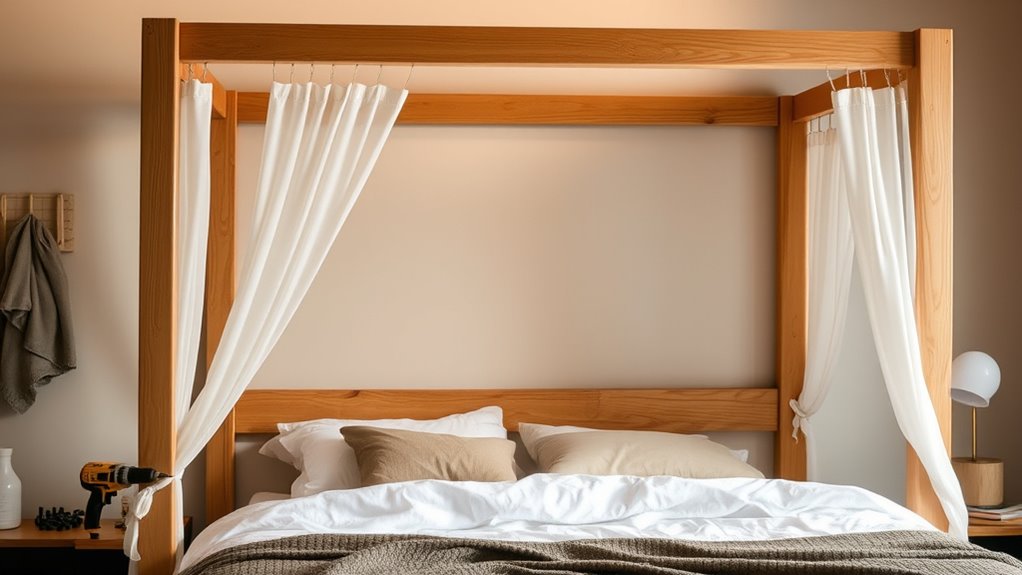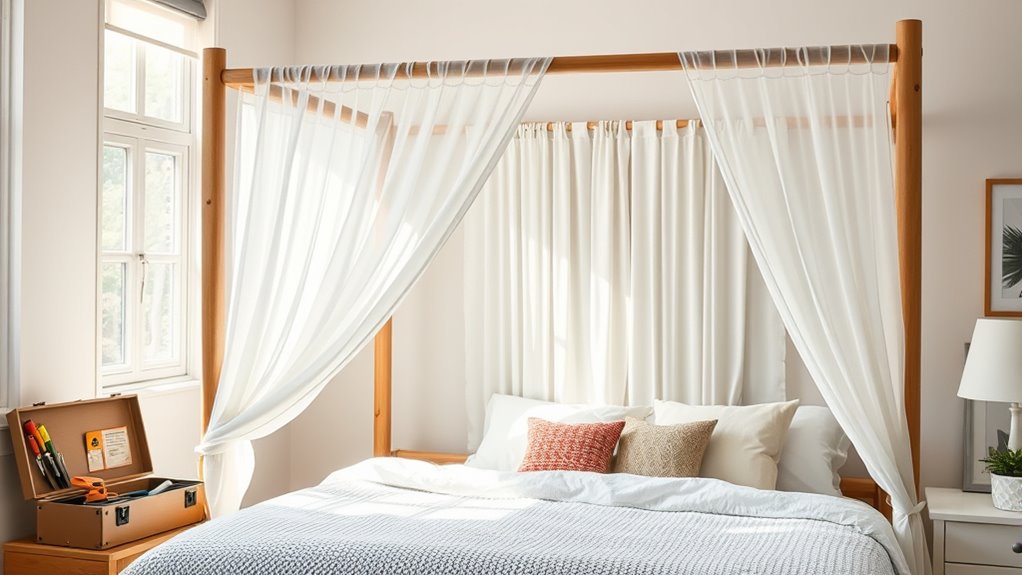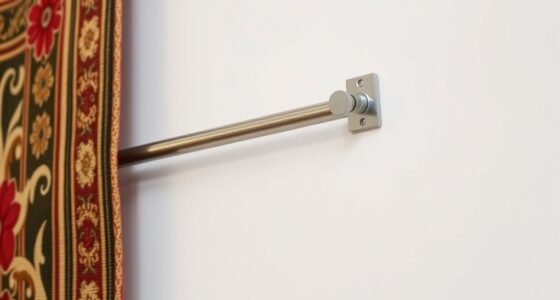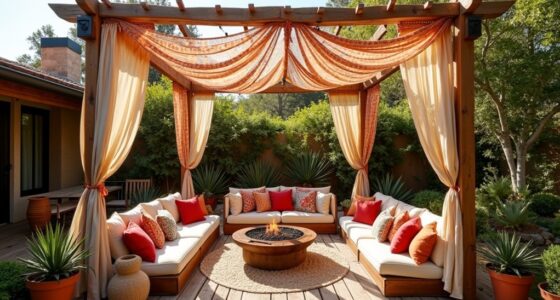To create a DIY canopy bed, choose a sturdy frame—wood, metal, or repurposed—based on your style and skill level, guaranteeing it supports the fabric and décor. Opt for lightweight, breathable fabrics like cotton or linen, or go for luxe velvet or sheer chiffon to fit your vibe. Attach the fabric securely with rings or clips and add decorative touches to personalize your space. Staying safe and stable is key, so double-check all hardware, and if you keep going, you’ll discover how to perfect your design and ensure long-lasting safety.
Key Takeaways
- Choose a sturdy bed frame made of wood, metal, or repurposed furniture to support canopy fabric and decorative elements safely.
- Select lightweight fabrics like cotton or linen for easy draping, or heavier materials like velvet for a luxurious look, matching your decor.
- Attach the canopy fabric securely using curtain rings, clips, or tiebacks, ensuring even draping and a polished appearance.
- Prioritize safety by using appropriate hardware, verifying stability, and regularly inspecting the structure to prevent accidents.
- Add personal touches with decorative trims, edging, and coordinated fabric choices to enhance style and create a customized, beautiful bed.

Creating your own canopy bed is a rewarding project that combines creativity with practicality. When you start planning, one of the first things you’ll need to contemplate is your bed frame options. You can choose from a variety of materials, such as wood, metal, or even repurposed furniture, depending on your style and skill level. For a sturdy, classic look, a solid wood frame offers durability and timeless appeal. If you prefer something more industrial or modern, metal frames can be sleek and easier to assemble. Alternatively, repurposing an existing bed frame can save money and add a unique, personal touch to your project. Whatever you pick, ensure it’s strong enough to support the added weight of the canopy fabric and any decorative elements you plan to include.
Once you’ve selected your bed frame, it’s time to think about canopy fabric choices. This is where your personality and style really come into play. Lightweight fabrics like cotton or linen are popular because they’re easy to work with, breathable, and hang nicely. If you want a more luxurious feel or a dramatic look, consider heavier fabrics such as velvet or brocade. Sheer fabrics like chiffon or voile can create a delicate, airy effect, perfect for a romantic or bohemian vibe. When selecting your canopy fabric, also think about color and pattern. Solid colors can be calming and versatile, while bold prints or patterns can make a statement. Keep in mind the overall decor of your room to ensure your fabric choices complement your existing style.
Choose lightweight cotton or linen for easy, breathable canopy fabric; opt for velvet or brocade for a luxurious look.
Attaching your chosen fabric to the frame can be straightforward if you use the right tools. You might opt for curtain rings, clips, or tiebacks, depending on the fabric and aesthetic you’re aiming for. Make sure to measure carefully so your canopy hangs evenly and gracefully. If you’re using multiple panels or layers, plan your layout before attaching anything to prevent uneven draping. For a more polished look, consider adding decorative trim or edging to your fabric, which can elevate the overall appearance and give your canopy a custom touch. Incorporating safety considerations during installation ensures that your canopy remains secure and stable over time.
Creating your own canopy bed allows you to tailor every detail to your taste, from the bed frame to the fabric choices. With a little planning and some basic tools, you can craft a stunning, personalized piece that transforms your space. Just be mindful of safety, especially when installing the canopy to make sure everything is securely fastened and stable. When you finish, you’ll have a beautiful, functional bed that’s not only stylish but also uniquely yours.
Frequently Asked Questions
How Do I Prevent My Canopy From Wobbling or Swaying?
To prevent your canopy from wobbling or swaying, focus on stability tips like securing the posts firmly to the bed frame and ensuring the joints are tight. Use brackets or brackets with screws at critical points for sway prevention. Adding weight to the base or anchoring the posts to the ceiling can also help. Regularly check and tighten connections to maintain stability and keep your canopy steady and safe.
What Are Eco-Friendly Materials Suitable for DIY Canopy Beds?
Eco-friendly materials for your DIY canopy bed are like a breath of fresh air. You should consider sustainable woods like bamboo or reclaimed wood, which are both durable and eco-conscious. Pair these with recycled fabrics for your curtains and bedding, reducing waste and environmental impact. These choices help you create a beautiful, sustainable space that’s kind to the planet while making your bedroom uniquely yours.
Can I Customize the Canopy Height Easily?
Yes, you can easily customize the canopy height. To do this, adjust the length of the support posts or frame components when assembling your bed. You can also modify the dimensions by adding or removing sections of the frame, allowing you to tailor the canopy height to your space and style preferences. This flexibility makes it simple to customize bed dimensions and achieve your ideal canopy height.
How Do I Incorporate Lighting Safely Into the Canopy Design?
You can incorporate lighting safely into your canopy design by using integrated LED lights, which are energy-efficient and produce less heat. Make sure to follow safety precautions like securely wiring the lights, avoiding exposed wires, and using proper connectors. Install the LEDs away from flammable materials, and consider adding a dimmer switch for adjustable lighting. Always test your setup thoroughly to guarantee it’s safe and functioning properly before use.
What Are Budget-Friendly Alternatives to Expensive Framing Materials?
You can explore alternative framing options like PVC pipes, which are affordable, lightweight, and easy to assemble. Wooden dowels or reclaimed wood also serve as cost-effective materials that add rustic charm. These options are budget-friendly and readily available, helping you save money while building a sturdy canopy bed. Just verify your chosen materials are strong enough to support the structure safely and securely.
Conclusion
Building your own canopy bed is a rewarding project that adds style and comfort to your space. With the right materials and safety precautions, you can craft a beautiful, personalized centerpiece. Did you know that DIY furniture projects like this can save you up to 50% compared to store-bought options? So, roll up your sleeves, get creative, and enjoy the satisfaction of creating a unique, cozy haven that reflects your personality. Your perfect bedroom retreat is within reach!









